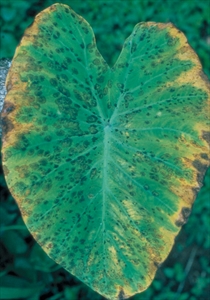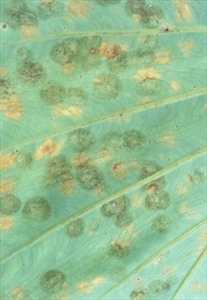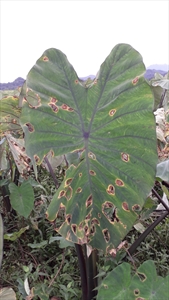- Widespread distribution. Asia, Southeast Asia, Oceania. Ghost spot has probably the widest distribution, and is likely to be present wherever the crop is grown. On taro. Minor diseases.
- Ghost leaf spot (Cladosporium), orange leaf spot (Neojohnstonia), white leaf spot (Pseudocercospora) and shot-hole (Phoma). On older leaves.
- Ghost – reddish-brown with light brown centres, not all penetrating to the undersurface; orange – yellow-brown, sometimes with yellow border; white – whitish-green, dark centres below, leaving white margin; shot-hole – brown up to 20 mm (larger than others), centres fall out leaving hole with yellow halo. All are spread in wind and rain.
- Cultural control: none recommended, as the spots are unlikely to affect yields.
- Chemical control: none recommended.
Pacific Pests, Pathogens, Weeds & Pesticides - Online edition
Pacific Pests, Pathogens, Weeds & Pesticides
Taro minor leaf spots (094)
Brown or ghost leaf spot, orange leaf spot, white leaf spot and shot-hole
Cladosporium colocasiae (brown or ghost leaf spot), Neojohnstonia colocasiae (orange leaf spot), Pseudocercospora colocasiae (white leaf spot), Phoma sp.(shot-hole). Phoma sp. is often given as Phyllosticta colocasiicola.
AUTHORS Helen Tsatsia & Grahame Jackson
Information from Carmichael A, et al. (2008) TaroPest: an illustrated guide to pests and diseases of taro in the South Pacific. ACIAR Monograph No. 132, 76 pp. (https://lrd.spc.int/about-lrd/lrd-project-partners/taropest); Photos 2,5&6 (Gerlach WWP (1988) Plant diseases of Western Samoa. Samoan German Crop Protection Project, Deutsche Gesellschaft für Technische Zusammenarbeit (GTZ) Gmbh, Germany. Photos 3&4 (taken by Eric McKenzie), and used in this fact sheet, appeared previously in McKenzie E (2013) Neojohnstonia colocasiae. PaDIL - (http://www.padil.gov.au). Photo 6-8 (taken by Eric McKenzie), and used in this fact sheet, appeared previously in McKenzie E (2013) Pseudocercospora colocasiae. PaDIL - (http://www.padil.gov.au). Photo 10 Mani Mua, SPC, Sigatoka Research Station, Fiji.
Produced with support from the Australian Centre for International Agricultural Research under project PC/2010/090: Strengthening integrated crop management research in the Pacific Islands in support of sustainable intensification of high-value crop production, implemented by the University of Queensland and the Secretariat of the Pacific Community.













